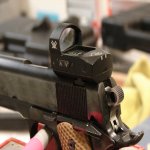The one that slides in, is the one too use.
When you tighten the screw , it should pull up on the insert and that wedges it tight into the dovetail. Too lose, make a tin shim. Feeler gauge works, beer can?
If you don't know what you are doing , don't use locktight. On a couple of guns ,I have had to use a thin shim ( tin can) under the rear to tip the front down so the red dot was near center of adjustment . If you need the front up, there is usually a little set screw to raise the front of the plate, on the 1911 ones I did, havn't did a glock.
You will not know ,unless you have in pistol vice and lined up on target, than set you dot to the spot, bullseye.
After everything is correct, you could lock tight, I never do.
I was going to say , you can buy a reverse drill, easy out ,CT has them , sometimes works, but if it don't you are drilling ,but see you already drilled it.
Did you try the heat?
Yes it was the loose one that i went with. The instructions talked about how to hammer the dovetail in and to put one of the screws into the hole so you did not deform the screw hole so it seemed like they were referring to the tighter one that really did not want to even start into the dovetail. My next move is to call Burris and ask them.
I did try heat (electric heat gun and soldering iron on the screw itself) along with a couple different easy outs but it would not budge. When I was drilling my biggest fear was affecting the gun slide itself, but in the layers i figured the worse I could do is wreck the amazon mounting plate that was being sent back anyway (in the long run the amazon one probably would have been fine but you know what happens when you overthink stuff). Once I drilled enough that the head came off, and the sight was removed, the leftover stud came out quite easily so i think I may have got some locktight on the bottom of the screw head itself and that was what was sealed down.
I have the sight remounted and on the gun. Good advice on waiting before loctite, but I did blue loctite it down and waiting for the full cure. Will take it out to the range today and see if it holds or shakes loose again.
Thanks for your help!









































































